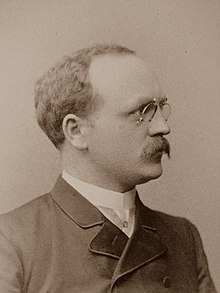
Back كارل بولفريك Arabic كارل بولفريك ARZ Carl Pulfrich German کارل پولفریش Persian Carl Pulfrich French Carl Pulfrich Italian Carl Pulfrich Portuguese
This article needs additional citations for verification. (August 2017) |

Carl P. Pulfrich (September 24, 1858 in Burscheid, Rhine Province, Kingdom of Prussia – August 12, 1927 in Baltic Sea, drowned when his canoe capsized) was a German physicist, noted for advancements in optics made as a researcher for the Carl Zeiss company in Jena around 1880, and for documenting the Pulfrich effect,[1] a psycho-optical phenomenon that can be used to create a type of 3-D visual effect.[2] Carl Pulfrich was the brother-in-law of Heinrich Hertz.[3]
- ^ Pulfrich, Carl P. (1922). "Die Stereoskopie im Dienste der isochromen und heterochromen Photometrie". Naturwissenschaften. 10 (25): 553–564. Bibcode:1922NW.....10..553P. doi:10.1007/bf01571319. S2CID 32802850.
- ^ Petzold, Axel (2009). "The Historical Origin of the Pulfrich Effect: A Serendipitous Astronomic Observation at the Border of the Milky Way" (PDF). Neuro-Ophthalmology. 33 (1–2): 39–46. doi:10.1080/01658100802590829. S2CID 15422373.
- ^ Appleyard, Rollo (October 1927). "Pioneers of Electrical Communication--Heinrich Rudolf Hertz--V". Electrical Communication. 6 (2): 63–77.